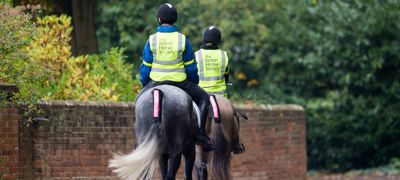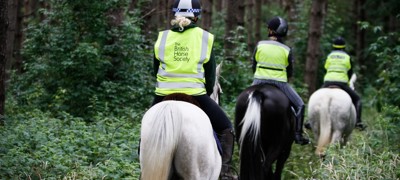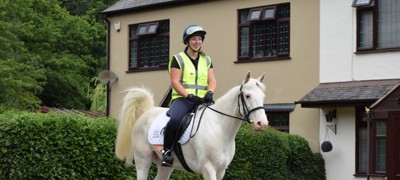Always leave a gate as you find it. Closed gates may be preventing livestock from escaping.
How to ride through gates
Patience is needed when teaching a horse how to negotiate a gate.
Before you ride through a gate, ensure your horse will:
- Stand patiently – with one hand on the reins, when you lean forwards out the saddle and down each shoulder
- Move off your aids – forwards, backwards and sideways
- Do a turn on the forehand – to both the left and right
It can be useful to have a helper on foot for the first few times you venture out, or team up with a confident friend and horse who can help you practice riding through gates safely.
Remember – practice makes progress!
 play-circle
play-circle
Watch
The BHS advice on opening gates
Heels to hinges
The “Heels to hinges” method is recommended as the safest method to negotiate a gate on horseback. The horse is positioned so their head faces away from the gate hinges, and your heels will face the hinges.
- “Heel to hinges” gives the rider best control of their horse and helps avoid tack being caught on the gate or latch
- Before riding through a gate, scan your route – are there any livestock in the field?
- Leave a gate as you find it – livestock may be in a field behind a closed gate, and a gate may be opened to ensure free passing from one field to another
- Where possible, keep one hand on the gate to control it. Take care if you cannot keep hold of the gate
- Never “fling” a gate open – it could bounce back and hit you or your horse. This could also damage the gate
- Always check the gate is secure before riding away
The gate opens away from the rider
chevron-down
chevron-up
- Stand the horse parallel to the gate, heels to hinges
- Lean over to release the latch, push the gate open till the opening is wide enough
- Turn your horse to bring their head into the opening and ride through the gap. Bend your horse around your leg nearest the gate
- Turn round the end of the gate and push the gate closed
- Make sure the gate latch is secure before riding away
The gate opens towards the rider
chevron-down
chevron-up
- Stand the horse parallel to the gate, heels to hinges
- Lean over to release the latch, then move your horse sideways away from the gate. Keep a hand on the gate and open it with your movement.
- Turn round the end of the gate when the opening is wide enough
- Once through the gateway, turn your horse parallel to the gate, heels to hinges, hold the gate and ask your horse to move sideways, closing the gate
- Make sure the gate latch is secure before riding away
Two-way gates
chevron-down
chevron-up
Two-way gates can be opened towards or away from the rider. Use the tips above depending on which way you choose to open the gate.
Always check the gate has closed properly before riding away.
Self-closing gates
chevron-down
chevron-up
Self-closing gates are designed to close automatically. There are various self-closing gate designs. They can often be problematic to horse riders, particularly if you are unable to hold the gate open while riding through the gateway. Self-closing gates can close quickly and can cause horses to panic or may hit the horse or rider. Before riding through a self-closing gate, if possible, it can be useful to see how quickly the gate closes before riding through.
Always check the gate has closed properly before riding away.
When heels to hinges cannot be used
It may not be possible to use the heels to hinges method if there is limited space surrounding the gate. This can be due to the position of the gate, posts or overgrown vegetation. If a gate is unsafe, report it to your local authority.
You can negotiate gates with the horse’s head over the gate; however, this is less safe as there is a greater chance of tack being caught and the rider needing to swap hands to open and ride through the gate.







